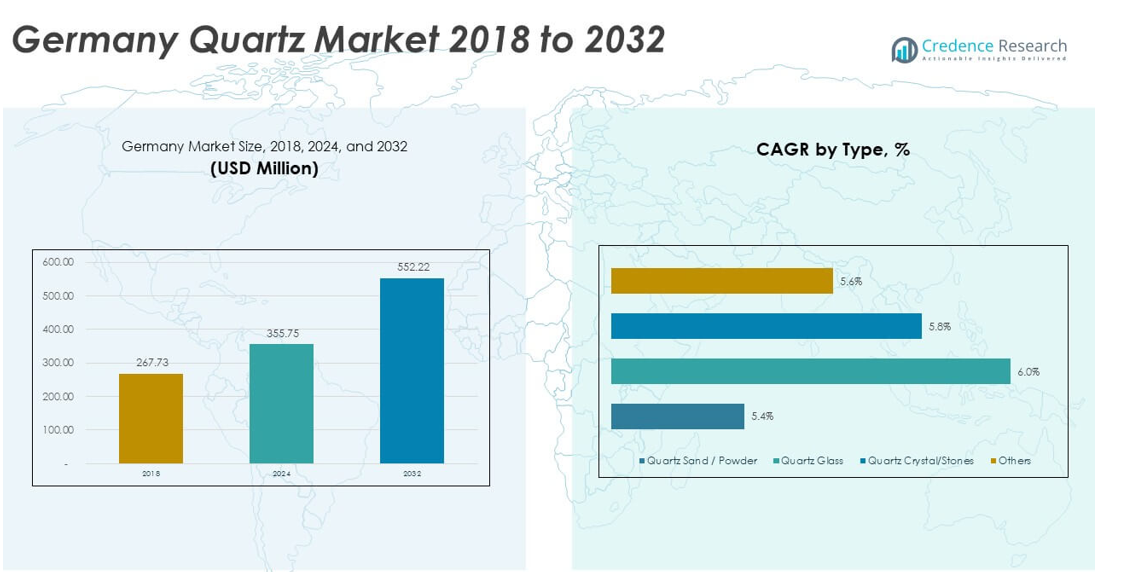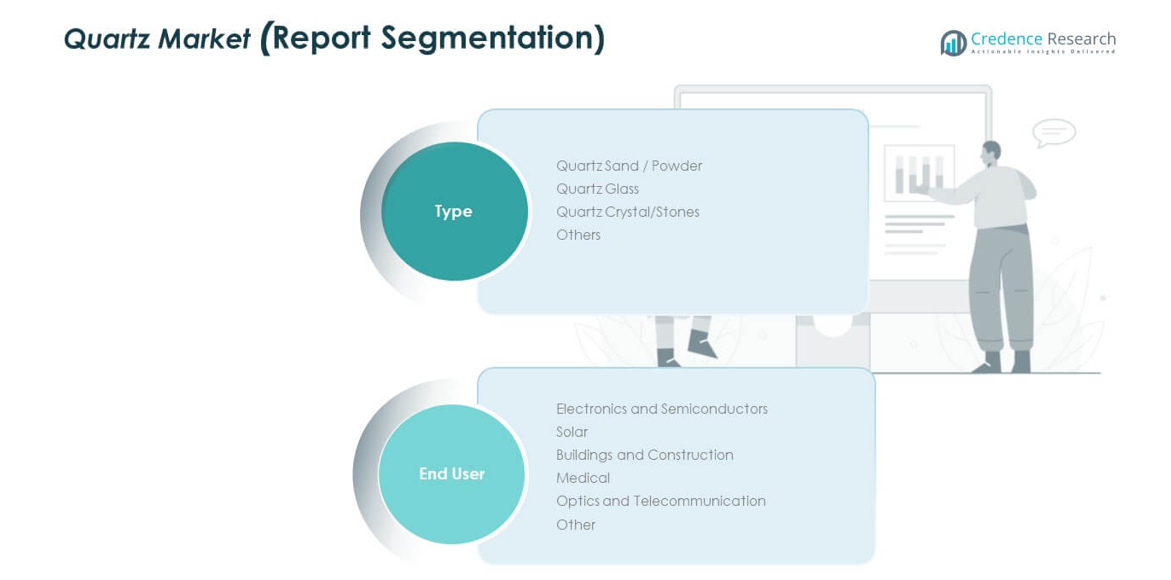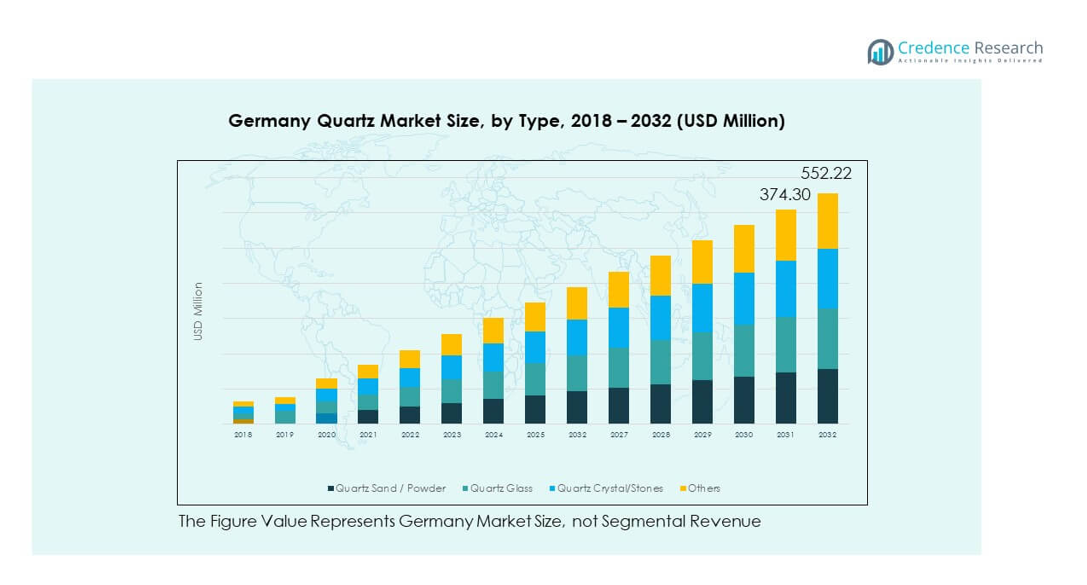Market Overview:
The Germany Quartz Market size was valued at USD 267.73 million in 2018 to USD 355.75 million in 2024 and is anticipated to reach USD 552.22 million by 2032, at a CAGR of 5.69% during the forecast period.
| REPORT ATTRIBUTE |
DETAILS |
| Historical Period |
2020-2023 |
| Base Year |
2024 |
| Forecast Period |
2025-2032 |
| Germany Quartz Market Size 2024 |
USD 355.75 million |
| Germany Quartz Market, CAGR |
5.69% |
| Germany Quartz Market Size 2032 |
USD 552.22 million |
The market growth is driven by rising demand from electronics, solar energy, and construction industries. Manufacturers rely on quartz for its durability, thermal stability, and purity. Strong adoption in semiconductor and optical applications also contributes to steady expansion. Growth in renewable energy investments, particularly solar panels, increases quartz demand. The construction industry utilizes quartz for surfaces, tiles, and composite materials, further boosting its share. Ongoing innovations in engineered quartz products attract both commercial and residential buyers. Government support for clean energy initiatives enhances consumption across multiple sectors.
Germany leads Western Europe in quartz consumption due to its strong industrial base. Demand is high across automotive, medical, and electronics sectors. Western regions dominate due to advanced manufacturing clusters and established infrastructure. Southern areas are emerging, driven by construction and renewable projects. Northern regions are expanding steadily with rising investments in clean energy. Eastern Germany shows gradual uptake supported by infrastructure development. Overall, Germany’s geographic diversity provides balanced opportunities for quartz adoption.

Market Insights:
- The Germany Quartz Market size was valued at USD 267.73 million in 2018, reached USD 355.75 million in 2024, and is anticipated to hit USD 552.22 million by 2032, at a CAGR of 5.69%.
- Western Germany held the largest share due to advanced industrial clusters, followed by Southern Germany with strong renewable and construction demand, and Northern Germany supported by trade hubs and clean energy initiatives.
- Southern Germany emerged as the fastest-growing region with rising solar projects and luxury housing driving quartz demand.
- Quartz sand and powder dominated segmental revenues with the highest share, supported by strong usage in electronics and construction.
- Quartz glass followed as the second-largest segment, driven by applications in solar and optical technologies, while quartz crystal and stones contributed smaller but stable shares.
Access crucial information at unmatched prices!
Request your sample report today & start making informed decisions powered by Credence Research Inc.!
Download Sample
Market Drivers:
Growing Demand from the Electronics and Semiconductor Industry:
The Germany Quartz Market benefits from increasing reliance on electronics and semiconductors. Quartz is essential for producing wafers, oscillators, and resonators. Its properties of stability, insulation, and precision support advanced applications. The country’s strong manufacturing ecosystem accelerates demand. The integration of 5G networks and IoT devices requires precise quartz-based components. Semiconductor fabrication facilities prioritize high-purity quartz for efficiency. Rising exports of electronic goods boost upstream consumption. Continuous innovations in microelectronics strengthen quartz utilization in Germany.
- For instance, Heraeus announced the expansion of its quartz glass production facilities in Germany in late 2024 to increase manufacturing capacity, specifically to meet surging demand from semiconductor fabrication and 5G-related applications.
Expansion of Solar Energy and Renewable Projects:
Renewable energy expansion provides a major growth driver. Quartz is widely used in photovoltaic panels, where purity and durability are crucial. Germany’s leadership in solar adoption raises quartz requirements. Investments in renewable capacity expansion amplify demand for quartz glass. Government incentives for solar installations encourage broader usage. The emphasis on sustainable energy strengthens domestic supply chains. Manufacturers align with policies promoting green energy technologies. It positions quartz as a material central to the energy transition. Future solar projects will secure its demand base.
- For instance, Schott successfully completed the acquisition of QSIL GmbH Quarzschmelze Ilmenau, a quartz glass production facility in Ilmenau, Germany, in early 2025, to support the semiconductor and microchip manufacturing industries.
Rising Demand from Construction and Infrastructure Development:
The construction sector contributes significantly to quartz demand. Engineered quartz surfaces dominate residential and commercial interiors. Quartz composites are valued for their durability and aesthetics. Germany’s steady housing development fuels adoption of quartz countertops and tiles. Commercial projects also drive quartz demand through flooring and cladding. Rising consumer preference for premium and sustainable materials enhances adoption. Builders and architects prefer quartz for both functionality and design. It ensures continued growth within the construction industry.
Innovation and Advancements in Quartz-Based Materials:
Product innovations shape the competitive landscape. Companies invest in new quartz composites with higher resilience and aesthetics. Engineered quartz offers stain resistance, heat tolerance, and customizable designs. Continuous R&D expands applications in medical devices and optics. German firms integrate automation in quartz processing to improve quality. Technological improvements also optimize cost efficiency and scalability. Product diversification allows suppliers to cater to multiple end-users. It ensures that the market maintains strong growth momentum in Germany.
Market Trends:
Increased Use of Quartz in Medical and Healthcare Applications:
The Germany Quartz Market shows growing adoption in healthcare. High-purity quartz supports advanced diagnostic instruments. Its durability ensures reliability in medical imaging and analytical devices. Quartz glass is also used in sterilization and lab instruments. Rising healthcare investments enhance demand for precision quartz products. Hospitals and research institutions increasingly adopt quartz-based solutions. The market benefits from Germany’s strong healthcare infrastructure. It strengthens the medical application segment as a key trend.
- For instance, Heraeus is a significant supplier of high-purity quartz glass used in the German medical device industry, serving both diagnostic instrument and laboratory equipment manufacturers thanks to its innovative production capabilities.
Shift Toward Sustainable and Eco-Friendly Quartz Products:
Sustainability drives innovation in the market. Companies develop quartz products with lower environmental footprints. Recycling quartz waste supports greener production processes. Consumers prefer eco-friendly engineered quartz in homes and offices. Germany’s environmental regulations reinforce this adoption trend. Manufacturers align strategies with sustainability goals. The use of renewable energy in production facilities becomes common. It establishes quartz as a sustainable choice in construction and industrial applications.
- For instance, leading manufacturers in Germany, such as Heraeus, are investing in large-scale, energy-efficient quartz glass production processes to reduce environmental impact and comply with evolving national standards.
Rising Integration of Quartz in Optical and Telecommunication Devices:
Optical applications create new growth opportunities. Quartz fibers and glass support communication technologies. Germany’s telecommunication infrastructure expansion increases quartz demand. High-speed internet deployment requires precision quartz components. Growth in fiber-optic networks strengthens adoption across regions. R&D in optical devices enhances product performance and reliability. Companies invest to supply the telecommunication industry with advanced quartz. It reinforces the role of quartz in technology-led expansion.
Growing Consumer Preference for Quartz-Based Interior Applications:
Interior design trends highlight quartz adoption. Engineered quartz dominates the kitchen and bathroom surfaces market. Its appeal lies in durability, low maintenance, and premium aesthetics. Consumers in Germany increasingly prefer quartz over natural stones. Retailers expand product portfolios to cater to these demands. Rising disposable income supports the premium surface material segment. Builders integrate quartz into high-end residential and commercial projects. It strengthens consumer-driven growth in the quartz market.

Market Challenges Analysis:
Volatility in Raw Material Supply and Prices:
The Germany Quartz Market faces challenges from raw material fluctuations. Quartz mining and processing rely on stable supply chains. Price volatility affects production costs for manufacturers. Import dependence on certain high-purity quartz sources raises risks. Disruptions in global logistics impact availability. Rising energy costs further strain margins for producers. Smaller firms struggle with cost management in volatile environments. It creates barriers to consistent growth in the sector.
Intense Competition and Market Fragmentation:
The competitive environment is fragmented with numerous players. International firms compete with established domestic producers. Continuous innovation raises pressure to differentiate offerings. Smaller companies face challenges in scaling operations. Price competition limits profit margins for certain products. Market entry barriers are high due to technology requirements. Firms must balance quality, cost, and customer expectations. It makes the market competitive and challenging for new entrants.
Market Opportunities:
Expansion in Renewable Energy and Green Technologies:
The Germany Quartz Market gains opportunities from renewable growth. Solar projects increase quartz demand for high-purity applications. Germany’s push for green technologies reinforces this trend. Manufacturers invest in advanced quartz glass to meet requirements. Export potential grows as renewable adoption spreads globally. It ensures strong long-term opportunities for quartz producers. Government support creates a favorable investment environment. The sector benefits from alignment with sustainability targets.
Diversification Across High-Tech and Emerging Industries:
Emerging industries expand quartz applications. Advanced optics, aerospace, and medical devices demand precision quartz. German R&D facilities foster innovations in new uses. Companies diversify portfolios to serve multiple industries. Partnerships with technology providers drive product adoption. High-tech industries rely on quartz’s unique physical properties. This diversification reduces reliance on traditional segments. It opens new growth opportunities for market participants.
Market Segmentation Analysis
Type-Based
In the Germany Quartz Market, quartz sand and powder dominate due to their use in electronics and construction. Quartz glass follows as a strong category, driven by applications in solar and optics. Quartz crystal and stone contribute through specialty applications in telecommunications and high-precision instruments. Other segments support niche industrial and decorative uses. Each type plays a unique role across end-use sectors.
- For instance, the competitive landscape includes major German and international players such as Heraeus, Saint-Gobain Quartz, and QSIL, all offering diversified quartz types serving electronics, solar, and optics end markets.
End-User
Electronics and semiconductors represent the leading end-user segment. Solar energy applications also hold strong market potential, driven by Germany’s renewable focus. Construction remains a consistent user due to the demand for engineered quartz. Medical applications show growing interest supported by healthcare infrastructure. Optics and telecommunications benefit from fiber and precision component usage. Collectively, these segments ensure diversified growth across industries. The segmentation highlights the balanced structure of the German quartz market.
- For instance, major domestic quartz suppliers like Heraeus, QSIL, and Schott have invested in capacity and product development to serve Germany’s advanced electronics, medical, and renewable energy sectors.

Segmentation:
By Type
- Quartz Sand / Powder
- Quartz Glass
- Quartz Crystal/Stone
- Others
By End User
- Electronics and Semiconductor
- Solar
- Buildings and Construction
- Medical
- Optics and Telecommunication
- Others
Regional Analysis:
Western Germany
Western Germany leads the Germany Quartz Market with the largest share. The region benefits from established industries in electronics, automotive, and healthcare. Strong infrastructure and R&D centers foster innovation. High consumer demand supports quartz use in construction and interiors. Export-oriented companies also thrive in this region. Quartz producers benefit from proximity to major industrial clusters. It positions Western Germany as the dominant market hub.
Southern Germany
Southern Germany shows strong demand growth across solar and construction industries. The presence of renewable energy projects drives quartz glass consumption. Luxury housing trends increase demand for engineered quartz interiors. Local manufacturing clusters support product innovation and supply chain integration. Construction investments strengthen quartz adoption across residential and commercial projects. Emerging startups add to the competitive environment. It makes Southern Germany an emerging leader in quartz adoption.
Northern and Eastern Germany
Northern Germany contributes through renewable energy and telecommunication projects. Ports and trade hubs support quartz imports and exports. The region benefits from offshore wind and solar development. Eastern Germany records steady growth, driven by construction and infrastructure. Government initiatives encourage industrial development in these areas. Healthcare expansions support quartz adoption in medical equipment. It ensures balanced contribution from northern and eastern regions.
Shape Your Report to Specific Countries or Regions & Enjoy 30% Off!
Key Player Analysis:
- Jauch Quartz GmbH
- MSI Q Quartz
- Quarzwerke Group
- Elkem ASA
- Caesarstone
- Heraeus Holding
- HanStone Quartz
- Santa Margherita Quartz
- Quarzglas Komponenten und Service QCS GmbH
- Hellma GmbH & Co. KG
Competitive Analysis:
The Germany Quartz Market remains fragmented with global and regional players. Firms compete across product quality, cost efficiency, and innovation. Domestic companies leverage strong supply networks to maintain competitive advantages. Global firms bring advanced technology and extensive distribution capabilities. Continuous product diversification shapes consumer preferences across industries. Partnerships and mergers increase market presence for leading players. Competition is marked by high demand in electronics, solar, and construction. It ensures both opportunities and challenges for participants.
Recent Developments:
- In September 2025, MSI unveiled seven new Q™ Quartz colors distinguished by bold veins and unique modern hues, aiming to add greater design versatility and appeal to its interior stone surfaces lineup. This update reflects MSI’s ongoing innovation and trend responsiveness within the premium quartz category.
- In September 2025, the Quarzwerke Group entered into a partnership with Eurovetro Srl through the acquisition of a majority stake. This collaboration is set to drive internationalization for Eurovetro’s glass recycling business and reinforce a more sustainable raw materials supply chain within the industry.
- On September 18, 2025, Elkem ASA announced it had entered an exclusive sales process for its Silicones division, marking a strategic step to streamline its core business and accelerate growth in silicon products and carbon solutions. The transaction, now in advanced negotiation with a global chemicals industry player, is expected to close in the first half of 2026.
- In July 2025, Caesarstone announced the launch of the Caesarstone ICON™ collection, introducing eight new, crystalline silica-free surface designs and retrofitting 19 existing quartz styles. ICON products now feature up to 80% recycled materials, setting a benchmark for sustainable, high-performing modern surfaces in the market.
Report Coverage:
The research report offers an in-depth analysis based on type and end-user segments. It details leading market players, providing an overview of their business, product offerings, investments, revenue streams, and key applications. Additionally, the report includes insights into the competitive environment, SWOT analysis, current market trends, as well as the primary drivers and constraints. Furthermore, it discusses various factors that have driven market expansion in recent years. The report also explores market dynamics, regulatory scenarios, and technological advancements that are shaping the industry. It assesses the impact of external factors and global economic changes on market growth. Lastly, it provides strategic recommendations for new entrants and established companies to navigate the complexities of the market.
Future Outlook:
- Rising adoption in renewable projects will sustain demand.
- Electronics and semiconductor industries will remain dominant users.
- Quartz glass consumption will grow in solar and optics.
- Medical applications will expand with healthcare innovation.
- Sustainable quartz products will gain consumer preference.
- Southern Germany will see faster growth in construction.
- Competition will intensify with domestic and global firms.
- High-purity quartz will remain a critical focus area.
- Export opportunities will strengthen through EU trade networks.
- Innovation in engineered quartz will drive premium markets.










